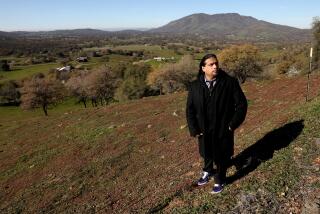Translated from Indian language, its name means...
- Share via
Translated from Indian language, its name means “Skunk Hill.” To later generations it was the second stop on one of the funniest “trains” ever to roll through America.
The city of Azusa, once known for countless acres of orange groves, then a brewery, a pay-to-fish trout farm, rock crushers and a Jesuit hideaway, today retains only the mountainside scars from quarrying.
What really put Azusa on the map was the long-running Jack Benny radio show on Sundays. As a regular gag, Mel Blanc (the voice of Bugs Bunny and other characters) cried out: “All aboard for Anaheim, Azusa and CUC-A-MONGA.”
At the time--the 1930s to the ‘50s--many thought the city had been named for its diverse qualities, an acronym for everything from “A to Z in the USA.” But in fact the city was christened by its first known residents, the Shoshone Indians, who dubbed their village Asuksa-gna, for the skunk population there. Spanish settlers called it El Susa.
As early as the 1850s, the town was a jumping-off point for those who caught “gold fever” and headed up Azusa Canyon into the forested hills in a mini-Gold Rush that endures with mixed results to this day.
But developer Jonathan Sayre Slauson discovered another kind of gold when, in the land boom of 1887, he subdivided the area and named it Azusa.
By the time the town was incorporated in 1898, it had survived natural and human disasters: floods, fires and an endless succession of fortune hunters, hydraulic miners, outlaws and squatters heading for Azusa Canyon’s gold mines.
By the 1920s, the town had discovered tree-grown gold: oranges. The citrus industry’s slogan, “Oranges for Health; California for Wealth,” drew more sun-and-citrus-mad Easterners than real gold.
In 1946, when the population neared 6,000, a Quaker school, Pacific Bible College, opened on the former site of Maybelle Scott’s School for Girls. It would later become Azusa Pacific University.
By the 1950s, the city was changing from a town of gravel pits and citrus groves into a manufacturing center, which included a Lucky Lager brewery.
By then, the heart of the town had virtually ceased to beat. After the Foothill Freeway was built, local businesses along Route 66 were bypassed. By the 1970s, most had closed down.
Although successors to many of the industries are still in Azusa, Lucky Lager and Happy Jack’s Fish Farm are gone. The 10 tranquil acres at the Manresa Retreat House are for sale: the Jesuits who lived there have fled from the encroaching development of 2,138 homes.
The city’s two big moneymakers are a new off-price store and the quarry, which is the source of as much controversy as tax revenue. The orange groves have vanished and the slopes of the San Gabriel Mountains, chewed up by quarrying, are marred by a scar as tall as an 80-story skyscraper.
The chief remnant of Azusa’s agricultural past is the 600-acre Monrovia Nursery Co., one of the nation’s largest horticultural wholesalers, and soon to be replaced with more of Azusa’s new cash crop: houses.
(BEGIN TEXT OF INFOBOX / INFOGRAPHIC)
AZUSA Inside Out / By the Numbers
ETHNIC BREAKDOWN
Latino: 54%
White: 36%
Asian: 6%
Black/Other: 4%
****
FAMILIES
Married couple families with children: 31%
Married couple families with no children: 20%
Other types of families: 21%
Nonfamily households: 28%
****
CITY BUSINESS
Date incorporated: December 29, 1898
Area in square miles: 9
Number of parks: 6
Number of city employees: 266 fulltime, 201 part time
1996-97 operating budget: 63 million (capital & restricted funds excluded)
****
PEOPLE
Population: 41,333
Households: 12,525
Average household size: 3
Median age: 27
****
MONEY AND WORK
Median household income: $31,889
Median household income / L.A. County: $34,965
Median home value: $151,800
Employed workers (16 and older): 21,341
Women in labor force: 59%
Men in labor force: 81%
Self-employed: 823
Carpoolers: 3,893
****
AVERAGE HOUSEHOLD INCOME:
$0 to $14,999: 20%
$15,000 to $24,999: 17%
$25,000 to $49,999: 39%
$50,000 to $74,999: 17%
$75,000 to $99,999: 5%
$100,000 or more: 2%
****
RETAIL STORES
Total stores: 249
Total employees: 1,784
Annual sales: $218 million
Source: Claritas Inc. retail figures are for 1995. All other figures are for 1990. Percentages have been rounded to the nearest whole number.
More to Read
Sign up for Essential California
The most important California stories and recommendations in your inbox every morning.
You may occasionally receive promotional content from the Los Angeles Times.













